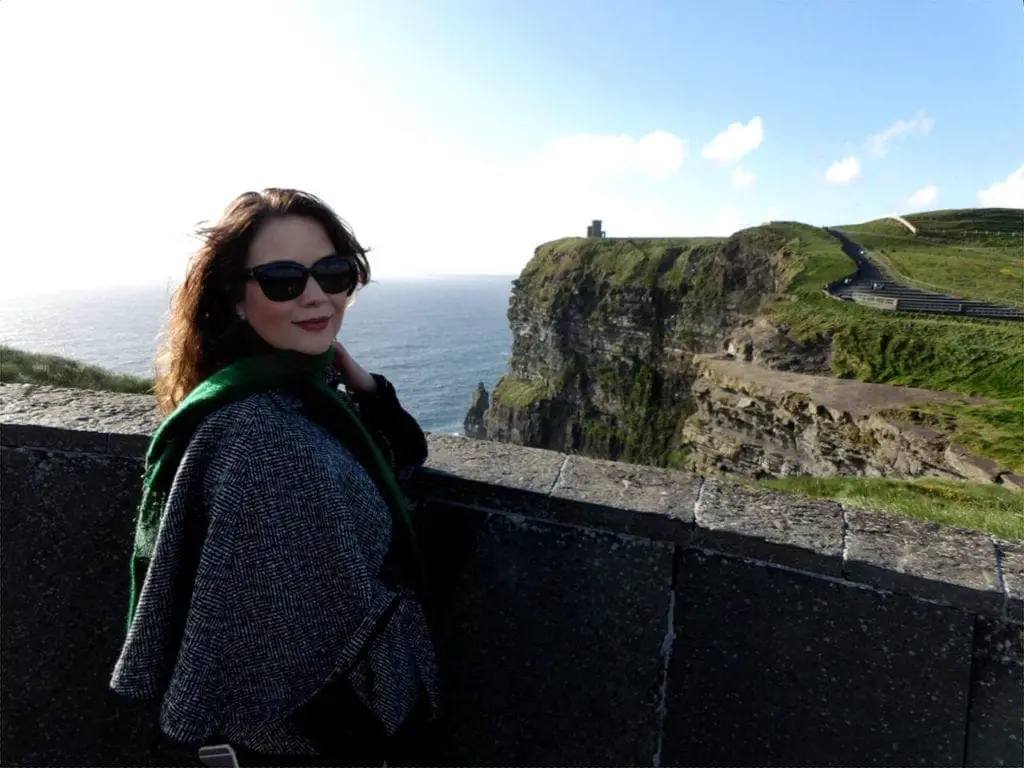Are the verdant fields and rugged coastal cliffs of “The Emerald Isle” calling your name? If you’re planning a trip to the Republic of Ireland, then this guide has got you covered.
When you Google “Ireland Travel Itinerary,” many guides recommend driving clockwise around the Republic of Ireland. And I’m here to tell you: “Don’t.” Ignore what many of the “experts” say (other than starting in Dublin) and drive counter-clockwise around Ireland.
- You’ll be going against the crowds and the large tour buses, limiting the potential for getting stuck in slow traffic.
- You “front load” your trip with some of the most spectacular views that Ireland has to offer (hello Cliffs of Moher in County Clare), and you’ll be in a more energized state than when you are rounding out the final days of your driving tour.
It’s not that Kilkenny, Cork, Kinsale, and the other towns along the southeastern area of Ireland don’t have their charms; they definitely do. And, if you have the time, visit them.
But, if the primary reason you are touring Ireland is to experience the otherworldly beautiful scenery and immerse yourself in the less “touristy” towns, then this is the path to follow.

Begin In Dublin

Quick Tips: Dublin
- Best Beer Tour: The Connoisseur Experience at the Guinness Storehouse
- Best Whiskey Tour: The Whiskey Blending Class at Jameson Bow St. Distillery. (The regular tour is also high quality and a lot of fun as well.)
- Church Architecture: Basically every church in Dublin is a feast for the eyes, but both St. Patrick’s Cathedral & Christ Church Cathedral are standout experiences.

- Oldest Pub in Dublin: Visit The Brazen Head (Est. 1198) but keep in mind it will most likely be crowded.

- Museums: Check out Dublinia for a taste of the Viking origins and medieval world of Ireland.
- Nightlife: Spend an afternoon or evening in the Temple Bar area. The cobblestoned streets are packed most nights, & there are markets, street performers, and a vast array of bars and restaurants like the now iconic, sprawling Temple Bar Pub offering up live music.

If you’re looking for a more in-depth guide to Dublin, check out: Top 9 Things To Do In Dublin Plus Best Hotels & Restaurants.
Recommended Dublin Hotels
The Fitzwilliam

I didn’t stay very long at The Fitzwilliam, but I loved my brief time at this purple-themed boutique hotel. It’s ideally located near Grafton Street within walking distance of Dublin’s cultural & historical attractions and there are loads of shops and pubs and restaurants nearby.

The Marker Hotel

If you enjoy a larger, more modern, and comprehensive hotel experience overlooking the rejuvenated river docks in the financial and tech sector of Dublin, book The Marker. It even has a coveted nightspot rooftop bar. If you’re a guest, you get premium entry.

Top Things to Do in Dublin
The Guinness Storehouse
“Located in the heart of the St. James’s Gate Brewery, the Guinness Storehouse® is Ireland’s most popular tourist attraction. It’s the home of the Black Stuff, the heart of Dublin and an unforgettable start to your Irish adventure.The journey begins at the bottom of the world’s largest pint glass and continues up through seven floors filled with interactive experiences that fuse our long brewing heritage with Ireland’s rich history. At the top, you’ll be rewarded with a pint of perfection in our world-famous rooftop Gravity Bar. Now that’s our kind of higher education.” | Guinness-Storehouse.com

Get ready for a 7 story tribute to all things GUINNESS. But also get ready to share in that tribute with loads of other people.
Visiting here can be truly overwhelming and even disorienting, which is why I recommend reserving the CONNOISSEUR EXPERIENCE.

Not only do you learn (and practice) how to correctly pull the beer from a tap, but you can also count yourself a member among an elite few. (Only 60 out of every 5000 visitors on average get to have this experience).

Plus, you get to taste original Guinness, and the variations of Guinness distributed around the world. Without this tour, I most likely would never have discovered Guinness Foreign Extra Stout, which is now my go-to favorite of the brand.

Definitely reserve ahead. The tour is currently the only one under their “Premium Experience” category.
But even if you don’t get to reserve ahead, the Guinness Storehouse is a one-stop-shop for history, fun, and family-friendly interactive experiences, dining, and, of course, beer tasting (there’s a lot of tasting).
REGULAR TOUR: All adult tickets include a complimentary pint of Guinness (with a valid ID). Under 18s, receive a complimentary soft drink.
CONNOISSEUR EXPERIENCE: “A five-star Guinness® tasting experience for the ultimate Guinness connoisseur, this intimate session takes place in our luxurious private bar where expert staff will be your personal guides on a sensory journey filled with tales and traditions.”

*Note: The 7th floor contains a 360° observatory of Dublin. And everyone knows it’s there. You should definitely go up but be aware that you might have to wait for a seating area or elbow your way past a few others to take in those views.
The Jameson Bowhouse Distillery
“In 1780 John Jameson threw open the doors of the Jameson Distillery Bow St. Over 200 years later, the doors are still open to friends old and new. Come for a distillery tour, a premium whiskey tasting experience, learn how to blend your own take-home whiskey or master the craft of whiskey cocktail making here in our home. All right here in the beating heart of Dublin, Smithfield.” | JamesonWhiskey.com

Address: Bow St, Smithfield Village, Dublin 7, Ireland
Hours: Open 7 Days a Week
If you get to the Distillery early for your tour, no need to worry. Enjoy a Whiskey Sour, an Irish Coffee, or any one of the other craft cocktails at the extensive bar.

Currently, Jameson Distillery in Dublin offers 5 different experiences. In the “Whiskey Blending Master Class,” you create your own blend to take home while also experiencing a cask draw and tasting in Dublin’s only live maturation house.
If you prefer to discover more about the history of Jameson and taste 4 premium Jameson blends (2 of which are only available at the Distillery, then the “Secret Whiskey Tasting” might be the one for you. If you don’t like the idea of sipping whiskey straight, then the “Whiskey Cocktail Making Class” should be a better fit.
There’s the regular tour of course, which covers the basics of how Jameson is made along with a comparative whiskey taste and a complimentary beverage in the bar at the end.
While I didn’t try the “Whiskey Cocktail Making Class,” I did go on the regular “Distillery Tour” and also signed up for the “Whiskey Blending Class.” The extra cost is worth it for the blending class. Informative, entertaining, tasty, and exclusive (like an adult chemistry class).
*Note: If you reserve the “Whiskey Blending Class,” there’s no real need to also go on the regular “Distillery Tour” because much of the same information is covered.

To explore which tour is right for your time and tastes, click the link below:
“When I die Dublin will be written on my heart.”
James Joyce
Day Trips from Dublin
If you think that Stonehenge and the Pyramids are sights worth visiting, then be sure to make time for the ancient sites of the Hill of Tara & Newgrange in County Meath. If you can only visit one site, then my suggestion would be the passage tombs of Newgrange. You can only visit Newgrange by guided tour, but it was one unforgettable experience.
The Hill of Tara
“Place of Great Prospects”

“142 Kings are said to have reigned in the name of Tara beginning in the Neolithic Age. The Lia Fail or “Stone of Destiny” was the site of a King’s coronation, and it was said that the stone would roar when touched by the rightful King of Ireland. Believed to be a dwelling place of the gods, the site was also fabled to be an entrance to the otherworld — a land of eternal joy and immortality. The oldest monument at the site is the Mound of the Hostages, a Neolithic passage tomb, dating from c. 3000 BCE.” | MythicalIreland.com
If you’re wondering if there is any connection between the “Tara” from Gone with the Wind and this hill in Ireland, then you would be right. Margaret Mitchell named Scarlett O’Hara’s iconic plantation “Tara” after the ancient seat of the High Kings of Ireland.

The Hill of Tara is a quiet, unassuming place accessed by a narrow road. Parking is roadside, and there are stores and cafes there for visitors.
To get to the Hill of Tara, walk the curving dirt path toward the old, white church that now serves as a visitor’s center. An attendant will then direct you to walk up the graveyard path, through the gate, and onto the plush grass of the rolling hilltops.

To get to the Stone of Destiny, you have to traverse the Ring Forts — there’s really no other way to do this than to half-trot down into the bottom of one ring, maintaining enough momentum to propel you to the top of the next.
Keep up this pattern with each successive ring. If it helps, imagine climbing up and down the humps of a giant green camel, and you can kind of get the idea.
After you’ve finished your walking tour of the Hill of Tara if you need a snack or are in the mood to shop, retreat to the parking area where you can grab a coffee or lunch at Maguire’s Cafe and Giftshop or a book from Michael Slavin’s tiny bookstore.
Newgrange

NEWGRANGE. Older than the Pyramids…Older than Stonehenge…the Neolithic passage tomb constructed in 3200 B.C. offers a mind-altering experience.
I recommend visiting it; I also highly recommend not relying on Google Maps to get you there. You’ll get there, but you’ll be on a road that runs behind the monument, and even if you walk the path to what looks like the ticket lodge, you will not be allowed to enter.
The only way to gain access is to go directly to the Brú na Bóinne Visitor Center: an artfully designed starting point with an informative film, a walk-through museum, a gift shop, and a (surprisingly) delicious cafe.
The tour bus loading point is about a 5-minute walk that takes you over a bridge with views of lush pastures dotted with Ireland’s quintessential sheep.

It’s a quick bus ride to the main passage tomb, and your guide will lead you up the hill and discuss the history of the site while you wait to enter.
If you have a large group, half will enter the passage first, giving you about 15 minutes to walk around the monument and the surrounding sites.

When it’s your turn to enter, you will walk single file into the dim passageway and carefully make your way through the ever-narrowing path to the circular room deep in the heart of the tomb.
Walking the slightly rising path to the inner chamber of the tomb will give you chills (the good kind), but if you are severely claustrophobic, you might want to skip it. Also, at one point, the guide turns off the lights in order to simulate the illuminating sunrise of the Winter Solstice through the “roof-box” at the opening of the passage. It doesn’t last long, but if you have children or are yourself afraid of dark and closed-in spaces, please be aware.

Newgrange is best known for the illumination of its chamber by the winter solstice sun through the roof box above the entrance.
“Its purpose is to allow sunlight to penetrate the chamber on the shortest days of the year, around December 21st, the winter solstice. At dawn, from December 19th to 23rd, a narrow beam of light penetrates the roof-box and reaches the floor of the chamber, gradually extending to the rear of the chamber. As the sun rises higher, the beam widens within the chamber so that the whole room becomes dramatically illuminated. This event lasts for 17 minutes, beginning around 9 am.

The accuracy of Newgrange as a time-telling device is remarkable when one considers that it was built 500 years before the Great Pyramids and more than 1,000 years before Stonehenge. The intent of the Stone Age farmers who built Newgrange was undoubtedly to mark the beginning of the new year. In addition, it may have served as a powerful symbol of the victory of life over death.” | Newgrange.com
Getting Away to Galway
Galway Tips
- If it’s getting late on a Sunday, forget about reservations at any of the downtown Galway restaurants. They all close early.
- Live music (both modern and traditional) is performed at every pub in Galway, but if you want to score a table with a view of the foot-stomping musicians, you’ll have to get there early. Downtown Galway is a popular spot.
Galway Hotel Recommendation: The g Hotel

If you’re looking for a luxurious hotel in Galway, then definitely consider staying at the 5-star G Hotel and Spa. While most of the time you’ll probably be dining in downtown Galway, GiGi’s Restaurant in the hotel is a delicious (and beautiful) place to eat as well.
For more information on GiGi’s, click here.

Day Trip from Galway: The Sky Road

Even if the skies are drizzling rain, a day-tripping venture along “The Sky Road” will make for a memorable way to spend a day while you’re in the Galway region. This stretch of road makes up a portion of the “Wild Atlantic Way” ~ a perfect name.

The wanderlust draw of “The Sky Road” is irresistible. To reach it, you can quickly cut through Galway towards R336, which runs directly along the rocky shoreline toward the town of Iverin. Thatched roof houses perch along the rocky coastline until you reach Roundstone County, a tiny slice of town in the midst of a land of rocks and waves.

Ashford Castle
Where History Meets Modern Luxury
“Your royal adventure begins when you enter through the grand stone gates of our remarkable 800-year-old castle. Discover our exquisite interiors, delicious cuisine, passionate team, a wealth of estate activities and state-of-the-art spa. As Ireland’s top hotel destination and former home of the Guinness family, we are exceptional in every sense.” Ashford Castle

I’ve never stayed anywhere quite like it. From the attention to every tiny detail to the genuine happiness of everyone working there, the entire experience of staying at Ashford Castle is impressive yet relaxed.

Whether you stay at Ashford Castle for a week, one night, or just a day visit, you won’t regret it. There is so much to do and see and explore both inside the castle and around its extensive grounds.

If you’re a guest at the castle, you are free to roam anywhere you like. There’s a library, a billiards room, and, of course, the spa. Once you’ve got the lay of the castle, head outdoors.
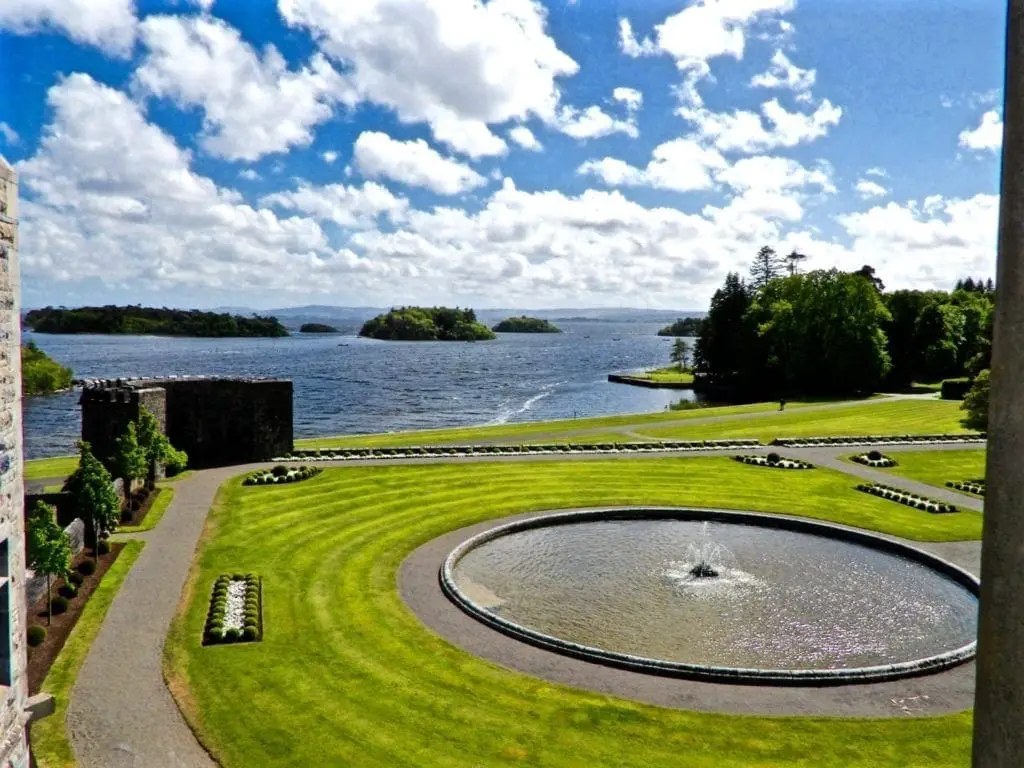
The grounds are surrounded by several gardens filled with ancient trees. There are also many outdoor activities ranging from golf and tennis to falconry, clay shooting, archery, and much more.
Fancy a traditional Afternoon Tea? Ashford Castle offers one of the best I have ever had.


Click for additional Ashford Castle offers.

The Town of Cong

If you’re in the mood for a longer walk from Ashford Castle, there is a path that takes you along the water’s edge and through the woods to the tiny town of Cong.


The movie The Quiet Man starring John Wayne was filmed on location there, which explains the statue and several other markers commemorating the film.
County Clare | Explore The Wild Atlantic Way

Whenever you see those wavy lines (white on a blue background) on a road sign–follow them. The signs will lead you to the Wild Atlantic Way.
“From the wind-whipped tip of Malin Head to the safe haven of Kinsale Harbour, wrap yourself in the wilderness of the west coast of Ireland on the world’s longest defined coastal touring route. The Wild Atlantic Way is a sensational journey of soaring cliffs and buzzing towns and cities, of hidden beaches and epic bays. So whether you drive it from end-to-end or dip into it as the mood strikes, it’s going to be a once-in-a-lifetime experience.” Ireland.com
Of course, if you’re on a tight schedule, you may not be able to drive every inch of this western coastal way, but the portion that runs through County Clare is definitely worth the effort.
Doolin Pier

I was told to go to Doolin to hear traditional Irish music, but what I found instead was much better: Doolin Pier. Curling green waves crash into the limestone shore, and in the distance, the Cliffs of Moher reach their jagged edges to the sky. If you can, try to visit the pier at sunset, where you can watch the skies shift from blue to gold.
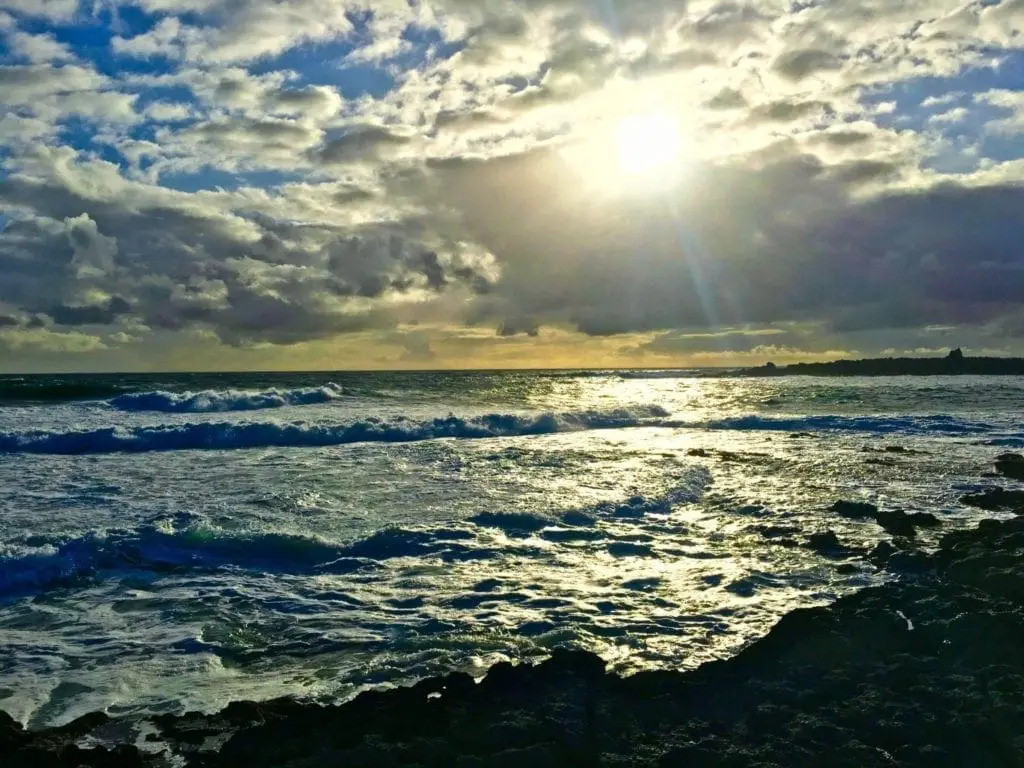
Doolin Pier is also the embarkation point for ferry tours around the Cliffs or to the Aran Islands in the summer months. For more information, visit Clare.ie
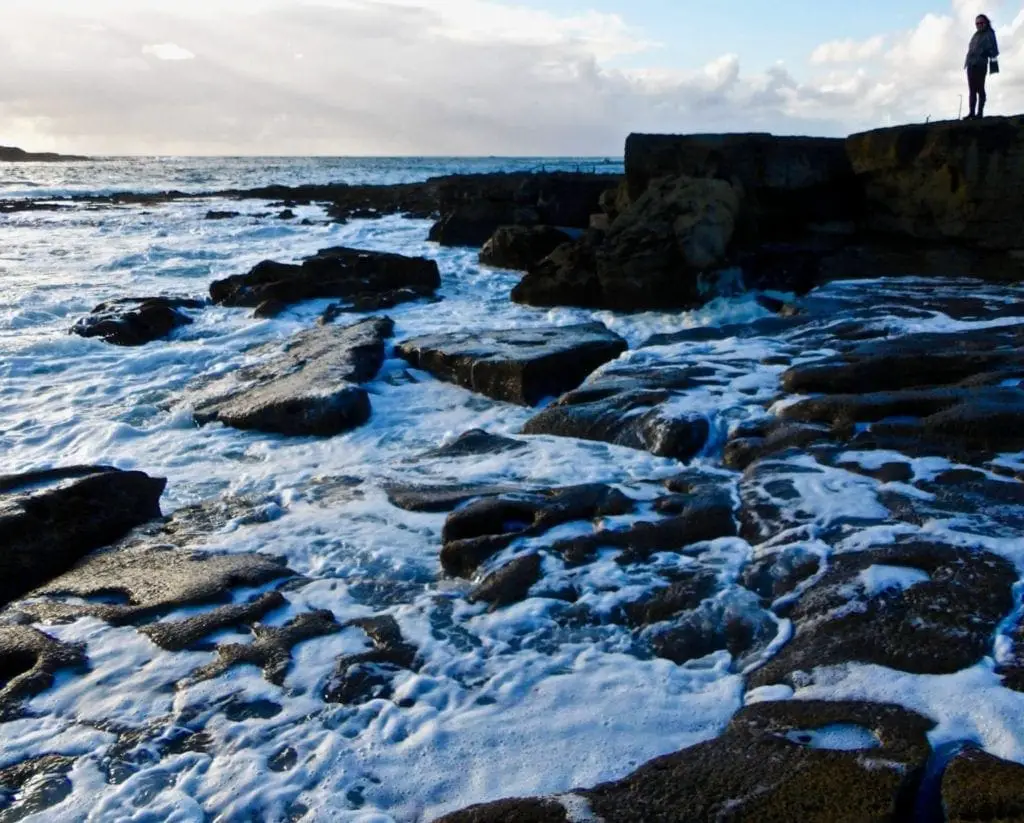
The Cliffs of Moher

“Step on to the edge of the world and into an awe-inspiring view that dreams are made of – at the Cliffs of Moher you will encounter nature in its wildest, purest form – see the rugged cliffs facing the mighty ocean, taste the salt air, hear the birds cry, feel the ancient rocks beneath your feet, smell the wind.” CliffsofMoher.ie
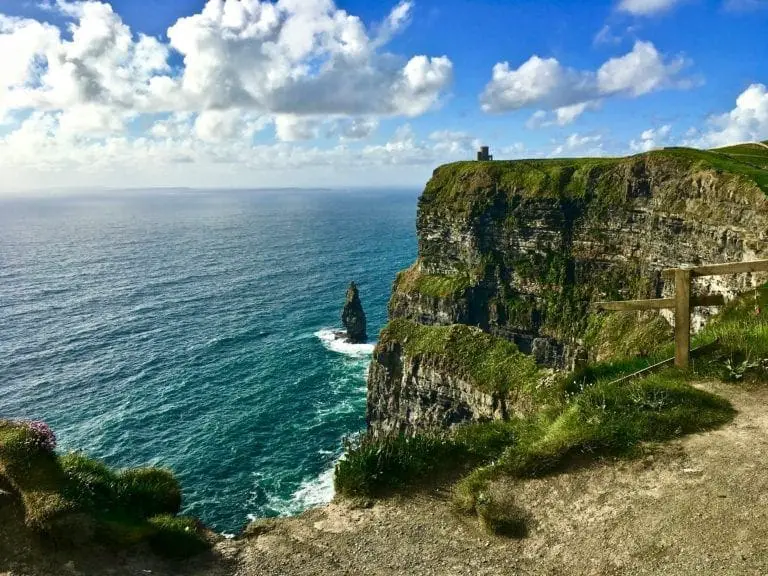
The cliffs have been attracting visitors since at least the 16th century. In the 19th century, Cornelius O’Brien built the iconic tower near the highest point of the Cliffs as a sort of early visitor and viewing center.
So, how long does a visit take? It’s completely up to you. CliffsofMoher.ie recommends a minimum of 2 hours, and some visitors spend half a day.
Note: July and August are peak tourist months, so if you visit in that timeframe, be aware that the site will be more crowded than usual, particularly between 11 am – 4 pm.
MONTHLY HOURS
January 9:00 am – 5:00 pm
February 9:00 am – 5:00 pm
March 8:00 am – 7:00 pm.
April 8:00 am – 7:00 pm.
May to August 8:00 am – 9:00 pm.
September 8:00 am – 7:00 pm
October 8:00 am – 7:00 pm
November 9:00 am – 5:00 pm
December 9:00 am – 5:00 pm


Tips for Visiting the Cliffs
DRESS WARMLY: The whipping wind around the cliff’s edge can be chilly, and since you’ll most likely be up there walking the paths for a couple of hours, staying warm is key.
FUNCTIONAL FOOTWEAR: Not only do you have to climb quite a few stairs to get to O’Brien’s Tower, but if you want to walk any of the older, original paths (at your own risk), you’ll need shoes with a good grip.
Of course, if you don’t want to venture onto those paths (they are clearly marked), 3 primary viewing platforms are structurally safe.
SAFETY FIRST: While it’s tempting to lean out over the edge and take a photo, remember that the cliffs are in a constant state of erosion.
There’s no way to know just how much earth is holding you up if you venture onto the older paths. So, if you do decide to explore those trails, stay back from the edge as much as you can.

Where to Stay in County Clare
The Bellbridge House Hotel
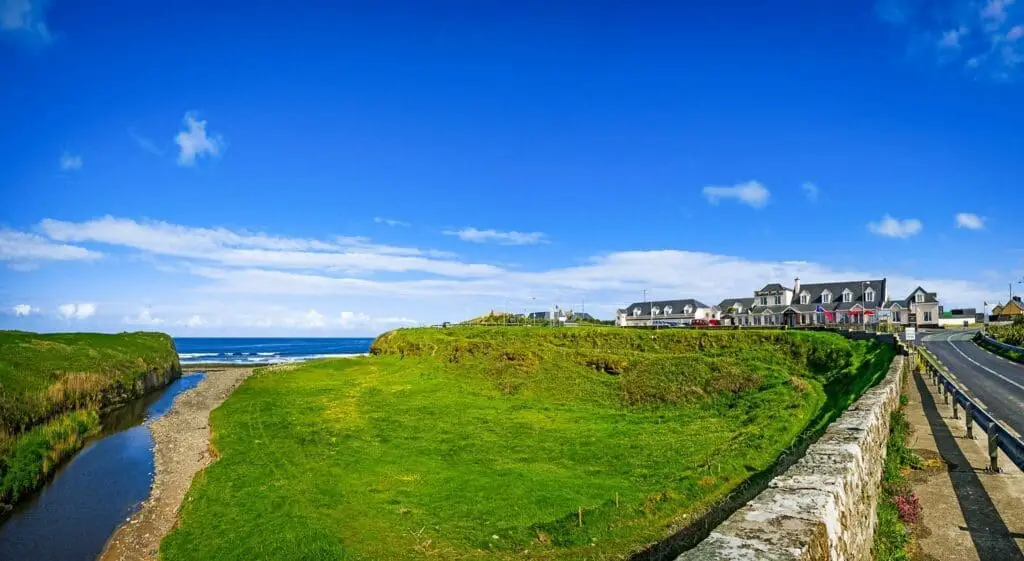
The Bellbridge House Hotel is a family run hotel, situated in the highly desired West Clare Coast, close to all the major attractions and activities that County Clare has to offer.
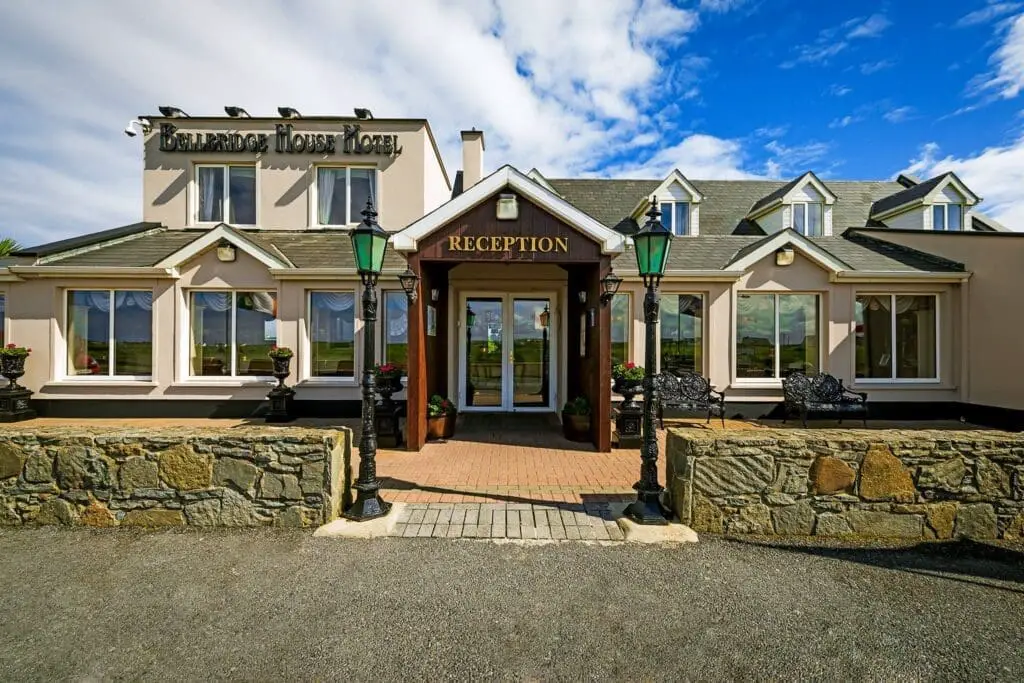
Take the Ferry to Kerry

If you continue on the Wild Atlantic Way towards County Kerry, you’ll be treated to some spectacular Atlantic cliff views like the one above. There are plenty of places to pull off on the side of the road, so stop, stretch, and smell the sea air.
You can either drive through Limerick or take the ferry, but I decided to opt for the ferry.
If you choose the ferry route, the road will take you through Kilrush: a land filled with windmill turbines, with their long, white, graceful needles circling languidly in the breeze.
For information on taking the ferry from Clare to Kerry, visit ShannonFerries.com.
The ferry itself is not glamorous; however, it is highly functional getting you to the other side in 20 minutes.
In the meantime, you can use the restroom facilities (also not glamorous but functional), and there is a snack bar. In the summer months, you can even see dolphins swimming alongside the ferry.

The Dingle Peninsula

As you drive towards the Dingle Peninsula, the coastal views give way to mountains with the ultimate scenic drive taking you through Conor Pass, the highest mountain pass in Ireland.

“Due to the nature of the road, there are length and weight restrictions, and vehicles such as caravans, camper vans, and trucks cannot use the pass.”
But, FYI, no one really pays attention to that warning.
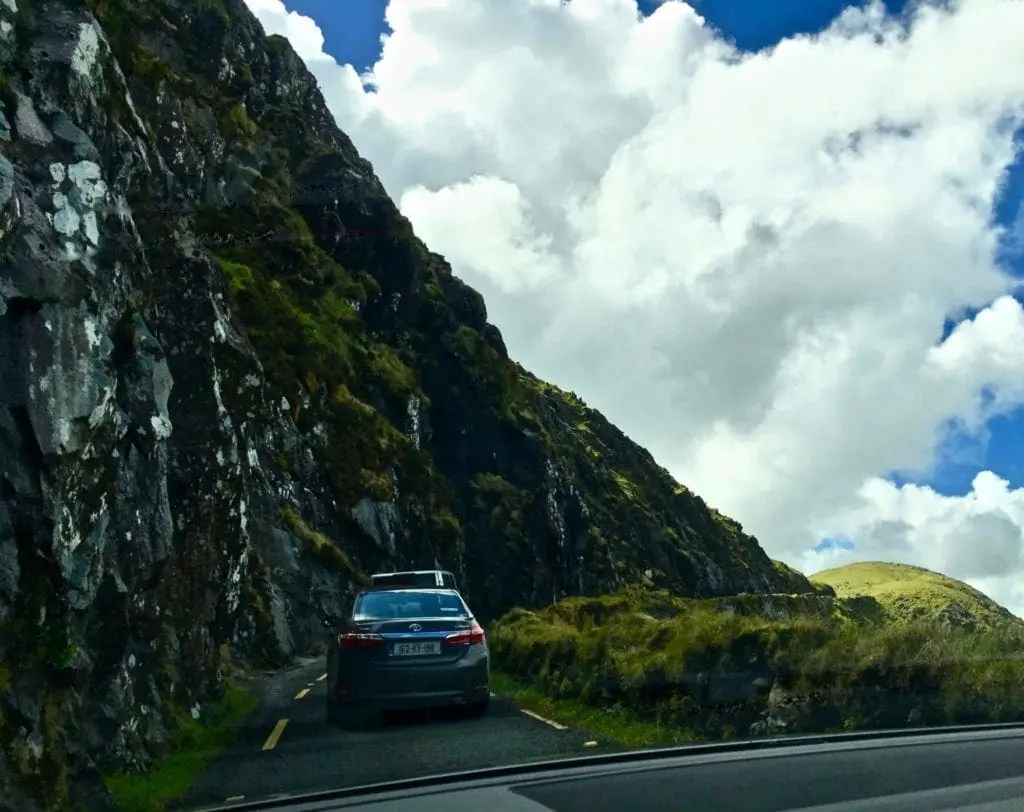
The drive through Conor Pass is slow going due to the narrow road and cliff-hugging curves. However, there are places to pull off, admire the views, and let oncoming traffic pass you.
I’ve seen message boards with travelers expressing their concerns about driving this particular road, and my answer is: do it.
But, this is also a moment to KNOW THYSELF. If you do not feel comfortable driving on the left side of the road in a rented car, or if you happen to be driving a large or oversized vehicle, do everyone a favor and choose a different road to the Dingle Peninsula.
If you do decide to brave the pass, you will be rewarded with boundless views of Ireland’s otherworldly landscape. (And sheep. Lots of random sheep).

The Town of Dingle
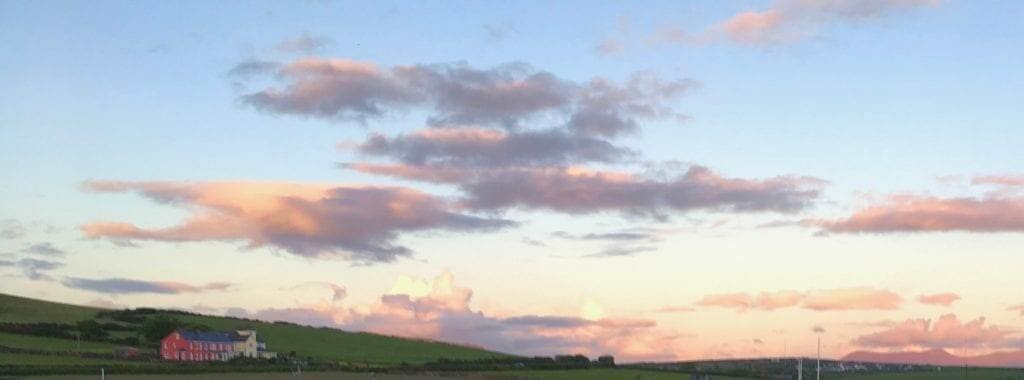
Dingle is a popular tourist destination, and if you want to get reservations at any of the top-rated hotels or B&Bs, then you need to reserve well in advance. At least 6 months in advance, but even earlier if you want to get the prime locations.
The best we were able to reserve was a room at the Dingle Skellig Hotel, a sprawling, older establishment that still maintained its seaside charm with panoramic views of the quiet inlet harbor and easy walking distance to town.
One of the hotel’s best features was breakfast served in the Coastguard restaurant. Floor-to-ceiling windows offer prime views of the blue peninsula and in the distance, the outline of the mountains of the Iveragh Peninsula. If you are traveling with kids, the Dingle Skellig Hotel prides itself on being kid-friendly as well.
Walk through downtown Dingle in the evening, and you’ll find that there is music pouring out of practically every bar and pub you pass. The trick is finding a seat or space to squeeze in.
Most pubs advertise their nightly live music, and while there are modern bands, I prefer the traditional ones. Get ready for a range of foot-stomping reels to melancholy ballads.
My favorite spot for traditional Irish music in Dingle is O’Sullivan’s Courthouse Pub.
It’s an extremely popular venue, so get there early to claim a space. Even though you still might have to peer around thick, wooden beams in order to catch a glimpse of the musicians with their accordions, violins, and guitars, you can hear them loud and clear.
The musicians play and sing late into the evening, lulling you into the cool dusky nights.
Dingle is a town loaded with charm and local warmth, but as with so many places, the word is out. The tourists, myself included, flock to the town, bringing with them oversized buses that crowd the narrow roads.
Even many of the shops that line the main streets of the town have succumbed to the tourist influx, offering an odd mix of the authentic goods of Ireland with the cheap trinkets that are more prevalent (and expected) in larger cities like Dublin.
Downtown Dingle Attractions

Downtown Dingle is picturesque and infused with Irish charm. The streets are lined with a wide variety of shops and there are pubs on pretty much every corner.
One of my personal favorites was Foxy Johns situated on Main Street. As the name suggests, Foxy Johns is not your ordinary watering hole. It is half hardware store and half bar.
You will most certainly find a few salty locals leaning into the bar, taking long cool gulps of Guinness in between a never-ending stream of jokes and bits of local news.
The Irish are so friendly and engaging that before you know it, one drink will turn into two and you’ll be leaning into the bar as well and laughing, even though you may not be certain about what.
The Dingle natives have a rollicking brogue, a melodic mix of English and Irish, colored by the salty flavor of living by the churning, misty seas of southern Ireland.
The Slea Head Drive


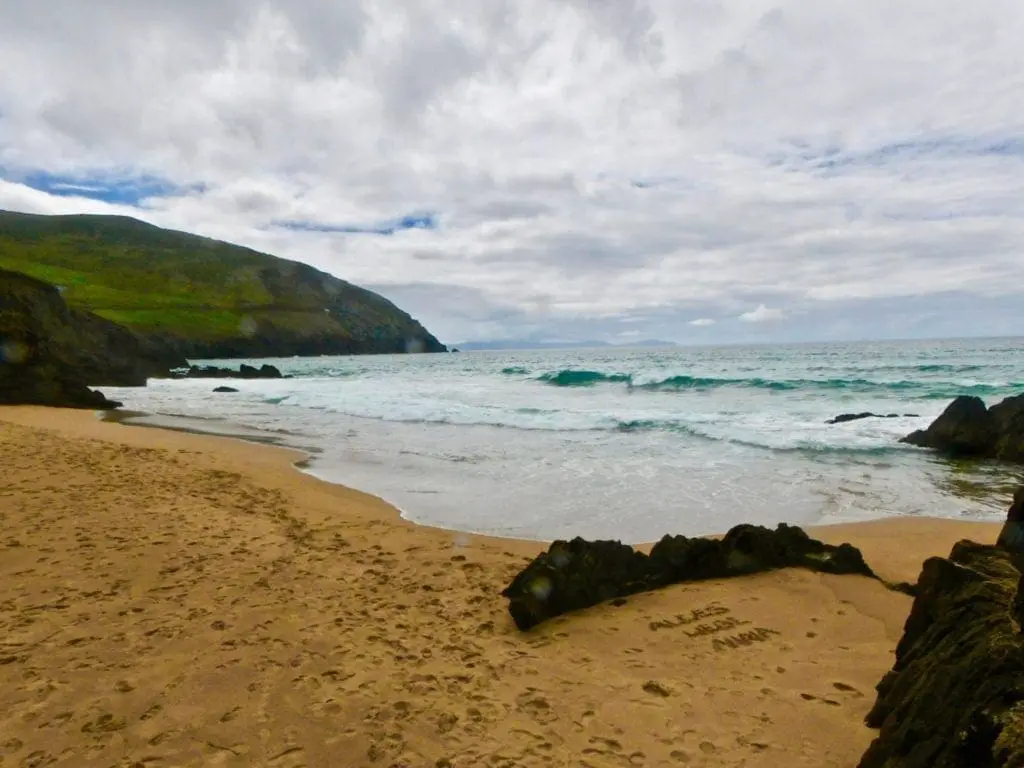
One great reason to visit Dingle is its easy access to the Slea Head Drive, a segment of the Wild Atlantic Way.
We chose, as was recommended, to drive clockwise around the circular drive in order to avoid getting gridlocked behind a large tour bus.
This drive, unlike some other stretches of the Wild Atlantic Way, offers plenty of pull-off spaces to either let traffic pass or pause to take a picture or just live and breathe in the moment.
The entire loop is around 30 miles (47km), and the time it takes you to drive those miles is really up to you.
There are so many places to stop and walk down to the beaches or tiny villages with one or two restaurants lining the main street. The first seaside village you’ll encounter after you leave Dingle is Ventry.


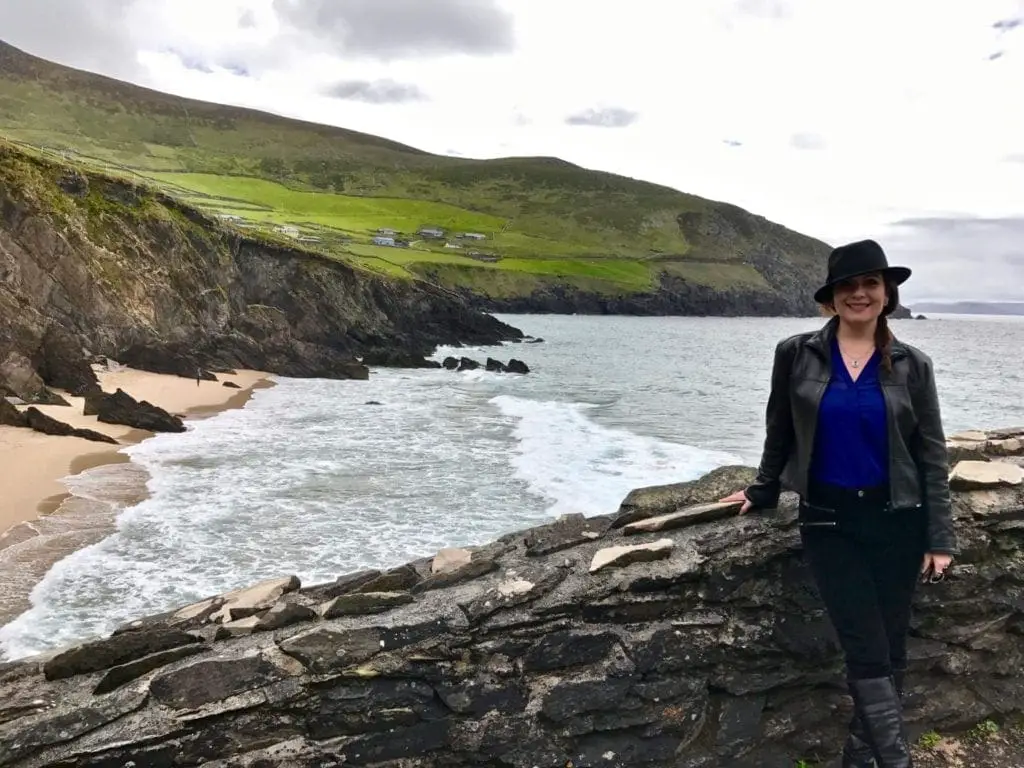
From Ventry, the landscape grows more dramatic as you angle towards the Slea Head with views to the Blasket Islands and the upward-sloping outcroppings known as the “The Three Sisters.”

While there are so many places to stop along the way to have a bite and a pint, the town of Ballyferriter offered the widest variety of options that didn’t take us off the path.
If you’re there and ready for a tasty break, stop in to Dig Ui Marcu Murphy’s, a moderately priced pub with a refreshing variety of options.
The Road to Killarney

While it may be tempting to go ahead and drive the Ring of Kerry on the way to Killarney, my suggestion is that you go straight from Dingle to Killarney.
Once you’re settled into your hotel or B&B, it’s much easier to day trip the Ring from a home base. The town of Killarney is absolutely beautiful and one of my favorites in southern Ireland.
Unfortunately, the hotel we booked looked great on the outside, but was the worst room we stayed in throughout the trip.
THE ARBUTUS is conveniently located downtown and the downstairs sitting room and connected pub are lovely, but the room was dark and chilly with two sagging twin beds. If you’re 6 feet tall or taller, your feet WILL hang off the end.
The furniture was also mismatched, and the bathroom’s fluorescent lighting flickered like a strobe for several seconds before settling into a dim, buzzing glow. I’m sure some rooms are better than others at the Arbutus, but I would double-check before I reserved.
Killarney Highlight | The Celtic Whiskey Bar & Larder

If you’re in Killarney and in the mood for whiskey, then definitely hit up The Celtic Whiskey Bar & Larder.
It’s the largest collection of whiskey I have ever seen. And don’t just go by the regular menu. Ask for the “bible.” They will bring you a massive book that contains the list of every whiskey they offer. If you enjoy a private tasting experience, they offer those as well. The food menu is also quite delicious, so you don’t have to worry about tasting whiskey on an empty stomach.
I tried the Flight of Premium Whiskey & Artisan Chocolate Pairing:
- Midleton Very Rare & Cocoa Atelier Vanilla
- Kilbeggan 21-Year-Old & Cocoa Atelier Mango
- Bushmills 21-Year-Old & Cocoa Atelier Ginger
- Connemara 12-Year-Old & Cocoa Atelier Salted Caramel
The Ring of Kerry

Driving the Ring of Kerry will take most of the day, especially depending on how often you plan to stop along the way to admire the windswept beaches or the ancient stone ring forts.
If time allows, include the additional Skellig Ring drive that traces its way along the Iveragh Peninsula with views to the Skellig Islands. To begin the drive, leave out from Killarney and head towards Muckross, driving through the Killarney National Forest. If traffic is light, it will take you around an hour to get to the beginning of the Ring (N70 route).
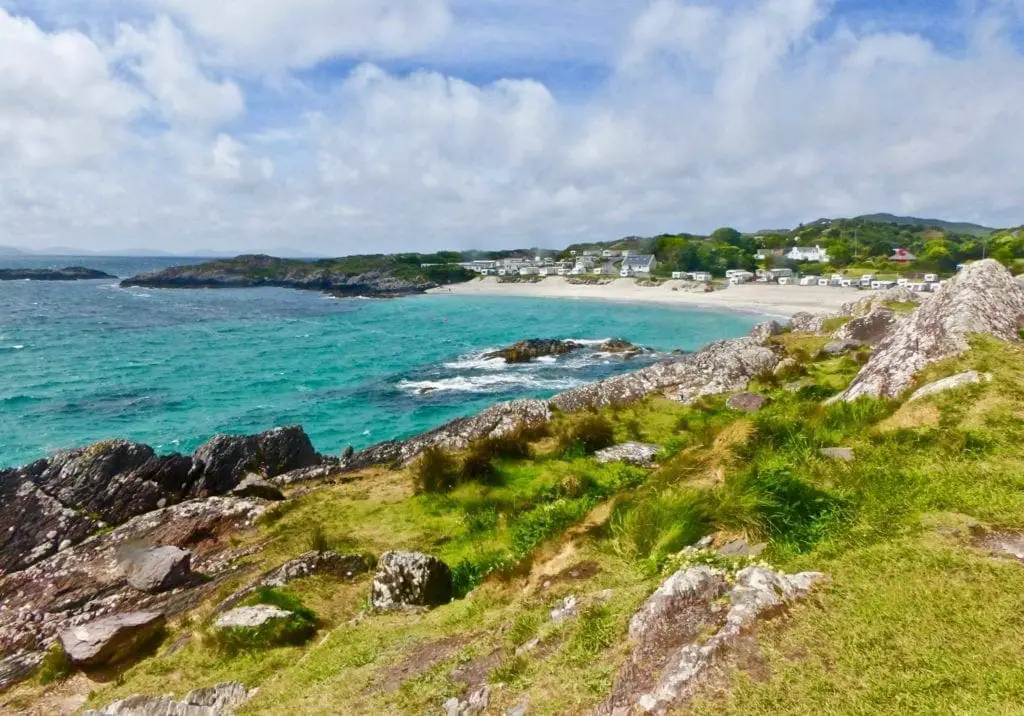
If that view doesn’t impress you, then the views from the Skellig Ring will. The road to get there, however, is easy to miss.
Look for a narrow path on the left just past Waterville with a sign that says “Skellig Ring.” Once you’re on the Skellig Ring, it’s a breeze to follow and will eventually lead you back around to the N70 and the traditional Ring of Kerry path.
The best vantage point for viewing the Skellig Islands from the mainland is from atop the Kerry Cliffs.

“The cliffs stand over 1000 ft above the wild Atlantic and truly offer some incredible photo opportunities, weather permitting. There is an entrance fee to the Kerry Cliffs of €4 euro per person which also gives you a discount in the coffee shop. The cliffs have been a viewing point for generations and a few years ago were developed with fencing, a carpark, coffee shop and camping by the local landowner. “
Wild Atlantic Way Online
Once you park and pay the small fee to enter, get ready for a fairly long walk to the cliff’s edge. On the way, you can stop in and examine replicas of the ancient monastic stone beehive huts found throughout the area and particularly on Skellig Michael.
The word “Skellig” by the way comes from the Irish word “Sceilg” meaning “rock in the ocean.” (Not quite as poetic but gets the point across.) At the cliff’s edge, you can either go right or left along the walled path. The left option presents a much steeper hike to its outcropping; whereas, the right ascends at a much gentler slope.
You’ll want to walk up both to see the views, so it doesn’t really matter. I suggest choosing the side with the fewest number of people milling around on top.




While the Cliffs of Kerry are not the tourist “hot-spot” like the Cliffs of Moher, they are just as impressive. When visiting, don’t expect a massive gift shop or fully-loaded tour guide.
The signs along the cliff path give brief overviews of the history of the cliffs, the surrounding Iveragh Peninsula, and the mystical Skellig Islands.
The entire visiting experience is quiet, except for the rushing of wind and ocean colliding rhythmically against the rocks.

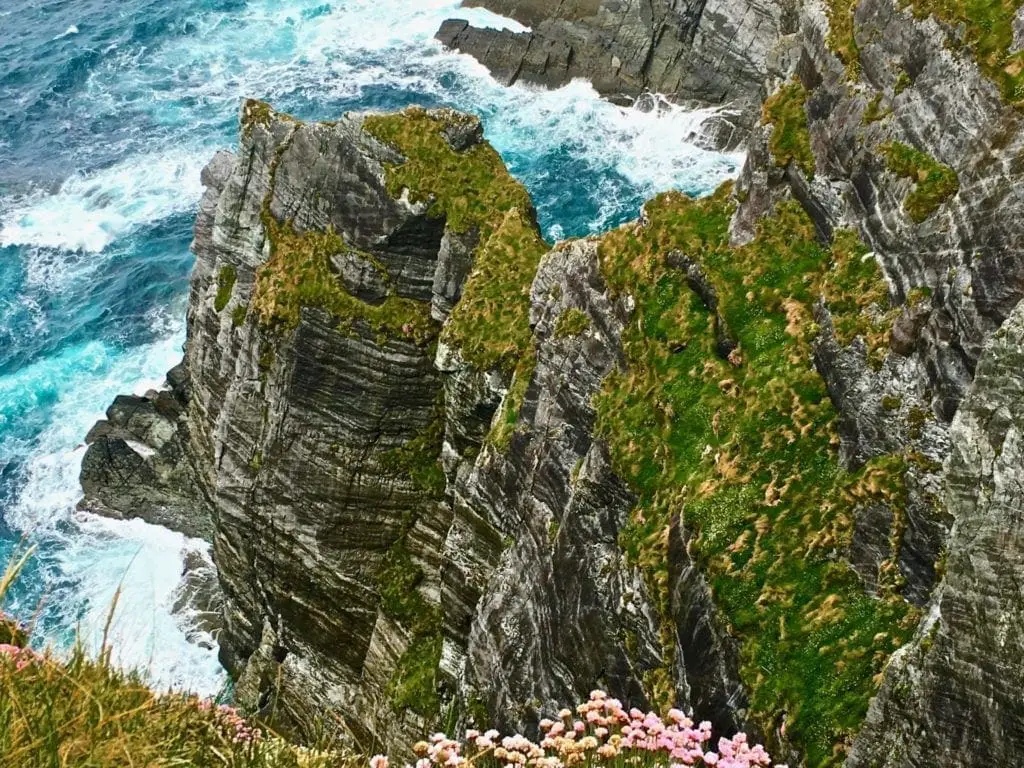
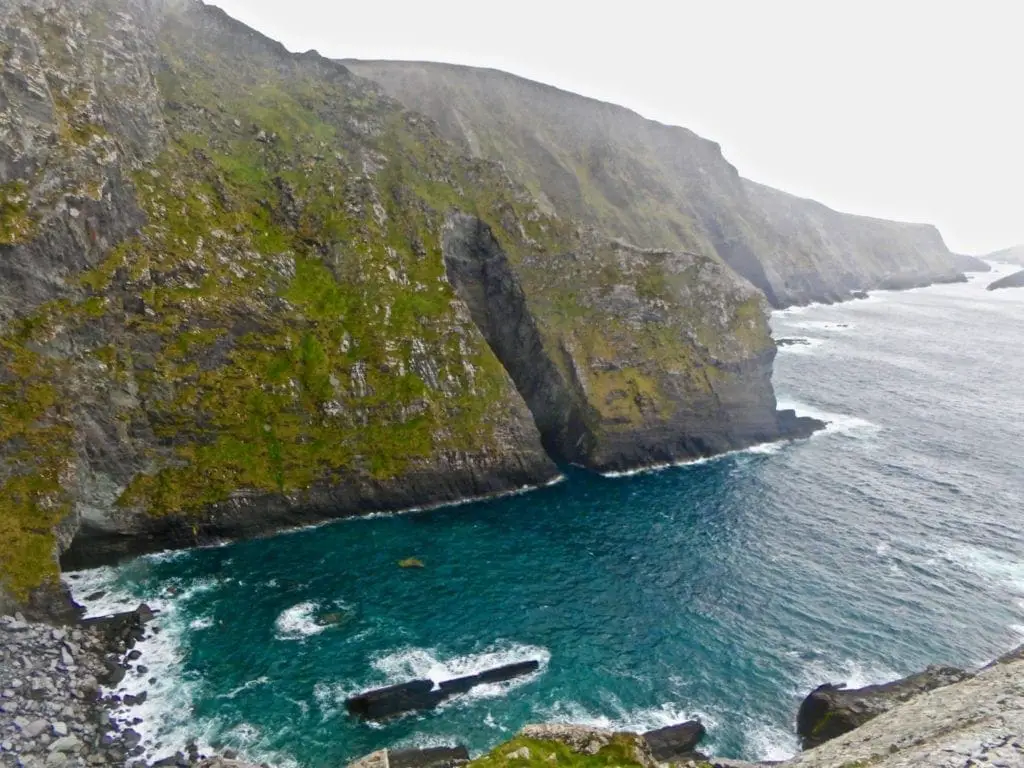

Skellig Michael
The popularity of this obscure island off the coast of the Ring of Kerry has skyrocketed since the debut of Star Wars: The Force Awakens and only increased since the release of the latest movie, Star Wars: The Last Jedi. We had fully intended to visit it and had even booked two boat tickets.
The day before the tour, however, a look at the upcoming weather led to a quick change of heart and, thankfully, a refund.
Weather: What to Know Before You Go
According to the “Skellig Michael FAQ” on WorldHeritageIreland.Ie, “The weather on Skellig Michael is unpredictable and therefore visitors should bring warm clothing and wet gear with them.
Appropriate footwear is essential as the steps can become slippery, particularly during or after rain…Skellig Michael is a precipitous island and the route to the top involves climbing about 600 steps to the monastery which is at a height of 180 meters.
Any visitor with health problems or a fear of heights should consider whether visiting the island is appropriate.
All visitors should take care when climbing both up and down the steps as there is no handrail and the ground slopes steeply away from the steps.”
The weather for our chosen day to visit would have created a nightmarish situation for us. While I would have loved to have seen and explored this otherworldly UNESCO WORLD HERITAGE site, I’m actually relieved I didn’t.
If you do choose to make the trek, read the additional FAQ here, and don’t forget to check the weather forecast. Refunds are only granted for a limited time, and you don’t want to pay for a trip that you don’t even take.
Killarney National Park

26,000 acres make up the woods, lakes, waterfalls, and mountains of Killarney National Park. There are so many places to visit, tour, or hike:
- Ross Castle
- Muckross House & Gardens
- Muckross Abbey
- Dinis Cottage
- Torc Waterfall
- O’Sullivan’s Cascade
- Ross Island
- Tomies Oakwood
Torc Waterfall

“A short walk…brings you to the waterfall. From that point, steps lead to another viewing point at a higher altitude that provides a view over the Middle Lake.
The path is also part of the Kerry Way long-distance walking route and a starting point for circular walking routes which are indicated by a map down at the start of the trail beside the car park.
The waterfall which is approximately 20 meters high is at its best after heavy rainfall.
Across the road from the car park jaunting cars can be hired for a trip to Muckross House within the National Park” | Killarney National Park
Ross Castle

“Ross Castle sits on the edge of Killarney’s lower lake and was built by O’Donoghue Mór in the 15th century. The Castle came into the hands of the Brownes who became the Earls of Kenmare and owned an extensive portion of the lands that are now part of Killarney National Park.
Legend has it that O’Donoghue still exists in a deep slumber under the waters of Lough Leane. On the first morning of May every seven years, he rises from the lake on his magnificent white horse and circles the lake.
Anyone catching a glimpse of him is said to be assured of good fortune for the rest of their lives. The large rock at the entrance to the bay is known as O’Donoghue’s prison. Ross Castle was the last stronghold in Munster to hold out against Cromwell.” | Killarney National Park
While I didn’t see O’Donoghue rise from the lake (kind of happy about that), I am glad I visited because the tour of the tower was fascinating.
For only 5 euros, the tour offers a vivid glimpse into what life was like in the 15th century: the good, the bad, and the very ugly (looking at you medieval communal restroom).
Killarney to Cork

If you’re headed to Cork, then I definitely recommend staying at the Hayfield Manor–a 5-star boutique luxury hotel within reasonable walking distance of downtown Cork. Or, you can have the hotel arrange for a cab to take you to the heart of Cork City.
After so many hours touring the Dingle Peninsula and the Ring of Kerry, collapsing in the luxury of this Irish Manor House offered a perfectly timed pause in the itinerary.


Even if you’re not staying at Hayfield Manor, stopping in for the afternoon tea is a lovely experience, and the bartenders at the Manor Bar (particularly a young man named Rory) were among the best we experienced in all of Ireland.


Day Trips from Cork | Kinsale
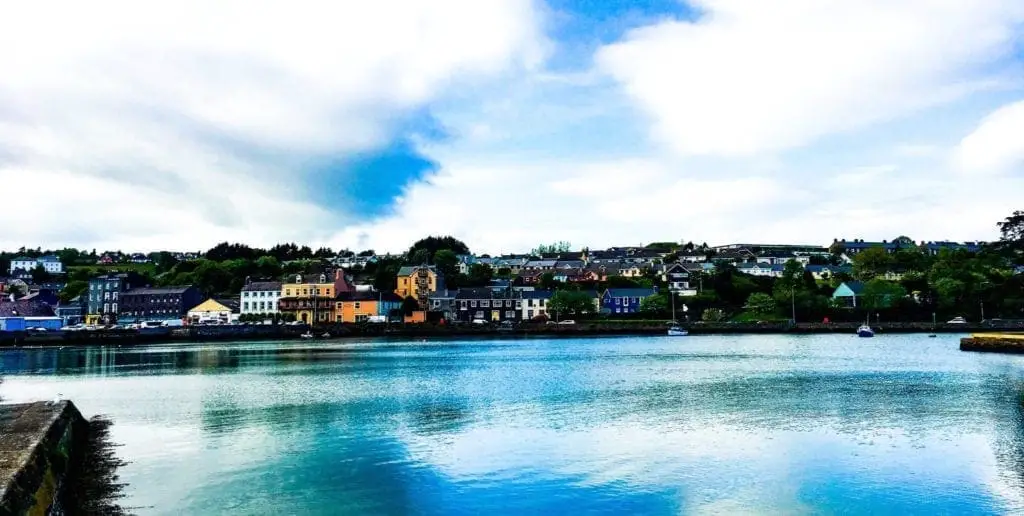
To describe Kinsale in a word: Lovely
This seaside port town is filled with shopping, pubs, restaurants, and sailing vessels. Spending a day here is the best for both sightseeing and relaxing.
Wander the winding streets, relax on a park bench, and soak in the views, or find a cozy pub for a warming whiskey or pint.

History of Kinsale | From the Anglo-Normans to the Lusitania
“Kinsale has been a centre of population, trade and fishing for centuries. The combined attractions of a sheltered harbour, fertile land and abundant fisheries were not lost on the invading Anglo-Normans who, in the 13th Century, displaced the local Irish to establish control and create a medieval walled town on the shoreline.
They forged trade links with England and Europe and became prominent in the wine trade. By the time Kinsale was granted its royal charter in 1333, it was already a thriving town and port.
On May 7th 1915 RMS Lusitania was torpedoed and sunk by a German U-boat off the coast of Kinsale causing the deaths of 1,198 passengers. The official inquest was held in the Kinsale Courthouse / Town Hall which is now a Museum.” Kinsale.ie

The Rock of Cashel

“The Rock of Cashel (Carraig Phádraig), more formally St. Patrick’s Rock, it is also known as Cashel of the Kings. Reputedly the site of the conversion of Aenghus the King of Munster by St. Patrick in the 5th century AD.
Long before the Norman invasion, The Rock of Cashel was the seat of the High Kings of Munster, although there is little structural evidence of their time here. Most of the buildings on the current site date from the 12th and 13th centuries when the rock was gifted to the Church.

The buildings represent both Hiberno-Romanseque and Germanic influences in their architecture.”| Cashel.ie


Kilkenny
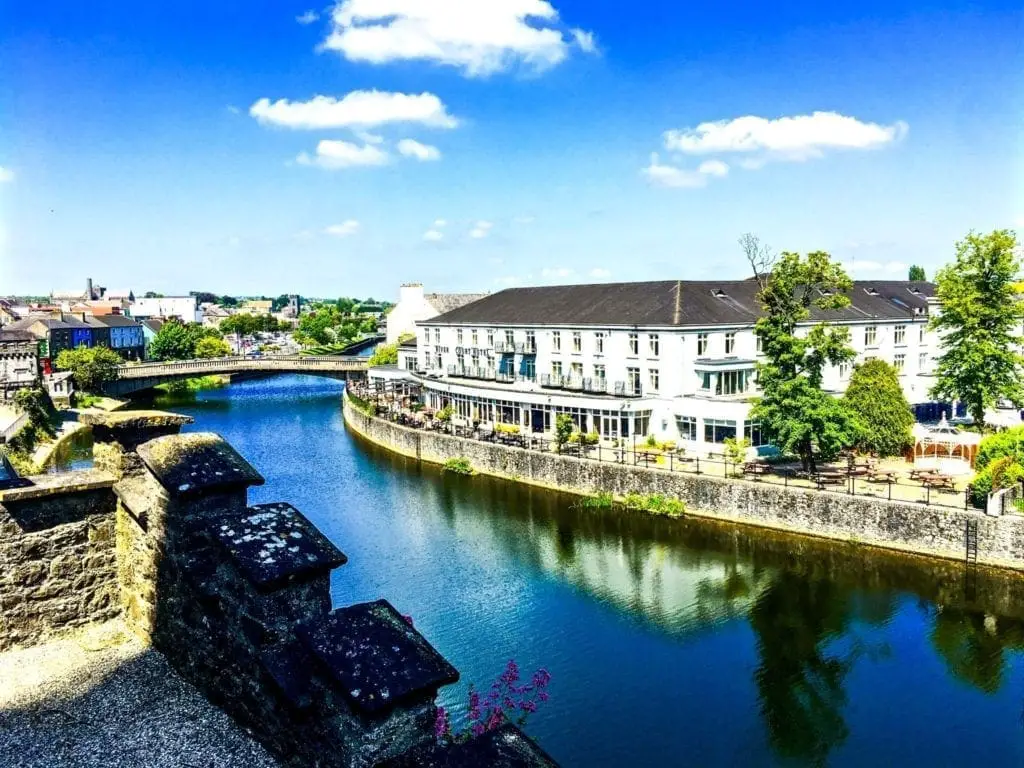
“Sitting on the stunning River Nore, Kilkenny is one of the most atmospheric and compact of Medieval cities.
Consisting of narrow slipways, historic landmarks, cheerful pubs, and bright-colored shop fronts, the Medieval Mile runs through the heart of the city, linking all of 13th Century Kilkenny together.” | Ireland’s Ancient East | Kilkenny Tourism
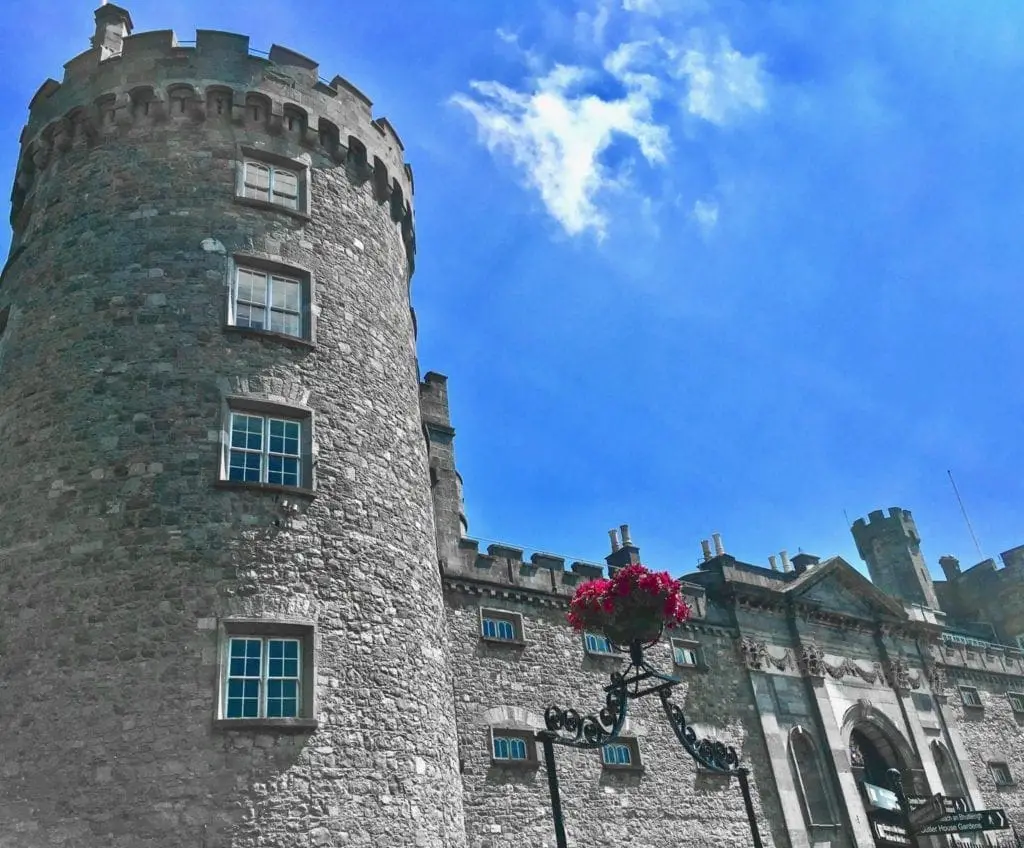

Kilkenny Castle is a highlight of this Tipperary town, and if time allows, tour it. Or, if you’re “castled-out,” buy a fresh lunch from the market vendors outside the castle walls, and enjoy a picnic on the garden grounds for one of the best views in town.
Ireland is full of so many charming towns, it’s easy to start to take them for granted. But, the town of Kilkenny is a standout: beautiful, laid-back, and easily walkable, not to mention brimming with excellent restaurant options.
If your palate is looking for a change from traditional Irish fare (potatoes anyone?), then try Ristorante Rinnucini. It’s an award-winning, lamp-lit Italian spot located on The Parade just across the street from Kilkenny Castle.
Fans of Smithwick’s Beer are in luck in Kilkenny because that’s where the Smithwick’s Experience Distillery Tour is located. It’s a highly informative tour regarding the ale, but in my experience, they crammed way too many visitors into one tour.
Ultimately, it turned out to be a hot, crowded tour. But, again, if you’re a fan of the beer, you will probably really enjoy the informative tour and tasting regardless.
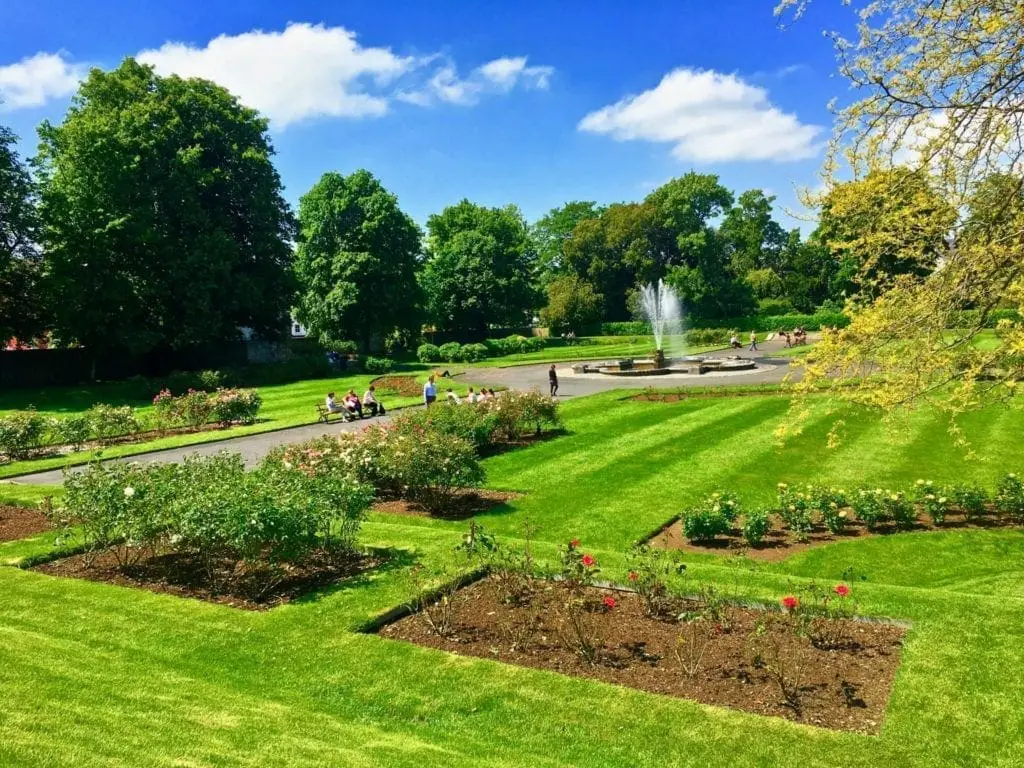
Winding It Up | County Wicklow

County Wicklow has its attractions, Powerscourt Waterfall being the most recommended. But, if I had to do it over again, I most likely would not choose to drive over the Wicklow Mountains through the National Park.
Once you are on that road, there is no turning back and it is quite a long and bumpy drive.
If you choose to drive it, make sure you have plenty of gasoline and water because there is nothing–literally nothing–but land stretching out for miles. And no cell signal whatsoever, but the scenery is so different from any other I had experienced in Ireland.
Essential Packing Item
Don’t forget to pack an umbrella! There’s a saying in Ireland. “If you don’t like the weather, just wait a few minutes.” Seriously moody weather.
So, to avoid getting inadvertently drenched, carry a compact travel umbrella with you. Sturdy enough to withstand winds, but small and light enough to toss in your purse or bag.
Before my trip, I ordered a couple of compact umbrellas from Amazon, and they kept me dry and happy from Dublin to Dingle.
Sláinte
While I know there is so much of Ireland that this guide doesn’t cover, I hope there are at least a few tidbits that sparked your interest or helped to shape your trip to the Emerald Isle.
It’s hard to go wrong with a visit to Ireland.
The dramatic landscapes alone are reason enough to go, but throw in the fact that it’s steeped in history, filled with fascinating architectural sites, and is home to some of the friendliest people in the world, and you’re going to want to linger.
